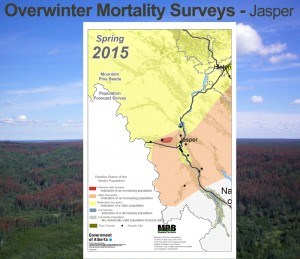
At least one prominent voice in Alberta's forestry industry is sounding the alarm about the consequences of leaving the mountain pine beetle unchecked in Jasper National Park.
“When I see what's already starting to die, I'm saddened because I'm not sure this park will ever be the same once the pine beetle goes through,” warned Paul Whittaker, president and CEO of Alberta Forest Products Association.
“I think people will be stunned in 10 years,” he said. “If we don't do something this park will change forever.”
Whittaker made his comments during the association's annual general meeting held at the Fairmont Jasper Park Lodge on Sept. 24.
He encouraged all levels of government and industry to work together to slow the spread of the beetle.
“What we need to do is make sure the folks in Ottawa understand how big a problem this is,” he said.
“The pine beetle isn't an issue in Ontario, so it's our job, to a certain extent, to help the government of Canada, the government of Alberta and industry work closely together.”
According to the provincial government's 2015 overwinter mortality survey, the beetle survived relatively unscathed in west-central Alberta this year, including in Jasper National Park.
“The indication is the beetle has done very well within Jasper,” said Bruce Mayer, the assistant deputy minister for agriculture and forestry.
According to a map he presented during the conference, the beetle did extremely well west of the Jasper townsite along the Highway 16 corridor and is moving eastward through the park.
“If they do go unchecked in the park there could be a migration of the beetle further east into forest stands that have not been attacked until now,” said Keith McClain, lead scientist for the mountain pine beetle ecology program with the Foothills Research Institute.
“It's a scary proposition to think about it,” he said in a follow up interview the day after the conference.
Over the past month, Alberta Agriculture and Forestry has been working in conjunction with Parks Canada conducting aerial surveys of the park to map out the number of red or fading trees—clear indicators the trees are dead and were infested by the beetle.
The beetle kills pine trees by burrowing under the bark and mining the phloem, the layer between the bark and wood of the tree. The beetles then lay eggs under the bark. After the eggs hatch, the grub-like larvae spend the winter feeding under the bark. The larvae pupate in the spring and emerge as adults from July to September before moving onto the next mature pine tree.
In addition to the aerial surveys, population assessments will be conducted on the ground to confirm their findings and count the number of newly infested trees.
“One of the positives they're seeing is that the beetle is just starting to make some of the cavities under the bark,” said Mayer.
"I'm not the expert on this, but doing it this late in the season means [the beetles] got a slow start so it may mean that come this winter they may not have as much success.”
Mayer said the full analysis should be completed by October.
The idea is that once the surveys are complete, the provincial government and Parks will then be able to come up with a joint management plan to focus their resources on priority areas in the park, explained Mayer.
Despite not having jurisdiction in the park, he said the province is committed to working with the federal government and will soon begin discussions to decide how much money both levels of government are willing to spend.
“I would hate to be on a panel that had to make a decision as to what to do in Jasper National Park because it's going to be a very, very tough decision,” said McClain, explaining that many of the solutions to slow the spread of the beetle—including harvesting healthy trees before they become infested—would be difficult to do in a national park.
Currently, Parks uses prescribed burns to eliminate old growth forest that has not been infested by the beetle and it has removed hundreds of healthy pine trees in town and around campsites, replacing them with trees transplanted from elsewhere in the park.
Parks Canada was unavailable for comment.
This year the provincial government set aside $35 million to fight the beetle. The Saskatchewan government also committed $1.25 million to help stop the spread of the beetle, which is currently about 150 km from the Saskatchewan border.
Despite the potential short-term impact, in the long run the beetle will help renew the park's old growth forests, explained McClain.
“There's no doubt the mountain pine beetle has caused tremendous damage to the pine forest in British Columbia and is doing a really good job in Jasper and here in Alberta, but in the long term, 100 years from now, our forests will be renewed and they will be healthy,” said McClain.
“The issue that we're going to have right now is that in areas where we never used to have mountain pine beetle we will have endemic populations of mountain pine beetle, meaning there's going to be a background level of pine beetle from now on.”
Paul Clarke
